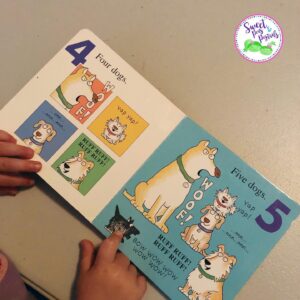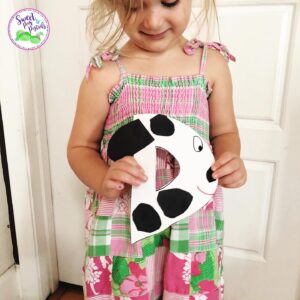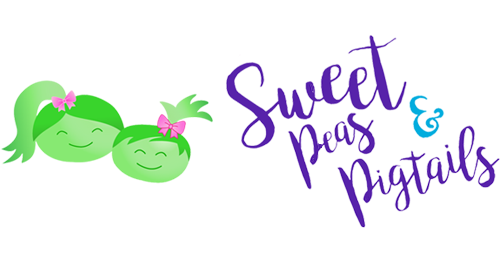This is one of my favorite all-time dog books! I read this book to my girls when they were younger and I will throw it in my therapy bag if I have a little one on my caseload. I’m always recommending Sandra Boynton’s books to friends who are about to have babies or to parents of children that I treat. If you have small children at home or on your caseload, and you’re looking to boost their speech and language skills, check this book out!
Below I’m going to share with you how I used this book with my own kids as well as the kiddos I see in speech. Hopefully you’ll be able to implement these ideas as well!
1. Animal Sounds
Did you know that animal sounds count as words?! Parents are often surprised when I tell them about this. In fact, if a child is not verbalizing or saying many words, I’ll often begin with a goal to produce animal sounds.
Now this book only has dogs in it (except for the surprise cat at the end), but each dog has a different bark! You can work on “woof,” “yap,” “ruff,” “bow wow,” “ar roof,” “arf,” “grrr,” “rrowff,” “aaaoooo,” and “raow.” So fun!

2. Basic Concepts
You can easily work on teaching basic concepts with this doggie book. The dogs pictured are different sizes and colors, and some have long hair while others have short hair. We also sometimes work on quiet/loud by saying our doggie sounds with a quiet voice and then with a loud voice… the kids get a kick out of that one!
3. Plurals
I have a confession. I don’t just use this book with toddlers and young preschoolers. I sometimes use it with five-year-olds that struggle using plurals. When teaching plurals, I often show one of an item (one pen or one toy) and then find the same item so I have two things. I usually say something like “here is one pen, here are two pens,” emphasizing the sound at the end of the word.
With this book, you can have your children count the dogs on each page and tell you how many dogs they see. If they leave off the ending sound to make a plural, repeat it back to them correctly, emphasizing the ending sound.
4. Articulation
There are plenty of sounds that you can target in this book- just scroll back up to point number two and take a look at all the different barks produced by the various dogs in the book!
Articulation, or how the child produces their sounds, is very important, don’t get me wrong. However, when children are young, building vocabulary is more important because you need language for functional communication.
While you are reading this book with your child, do emphasize and exaggerate the different sounds and make sure they can see your mouth. Who knows, he or she might surprise you and “bark” like one of the doggies, especially if you are reading the book over and over.
If you have a two- or three-year-old with good language skills, definitely see if they can imitate the /d/ sound as that is a sound that they should be able to produce at that age.
5. Letters and Numbers
We homeschool, and when the girls were preschool age, we of course worked on learning letters and numbers. This book is perfect for teaching the letter “D” as you can have your child look for all the “D’s” in the book. We then would talk about what sound “D” makes and then talk about how “dog” has that sound. After that, we would try to think of other words that start with that sound.
This book also inspired us to make a craft! This would be a fun project for your little ones at home or in speech while you read the book. 😊

Let me know if you have read this book in speech therapy or with your little ones at home. I’d love to hear how you use it! If you would like some more fun speech & language activities to use with your little ones, check out my Teachers Pay Teachers Store!

This is great! My 6 year old son has a speech delay and he goes to speech therapy. My wife and I have always read to our kids starting from a really young age. We have noticed that the more that we read to him and have books that he enjoys the more that it pushes him to try and sound out more words. We have also used board games as a way to encourage speech and articulation.